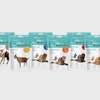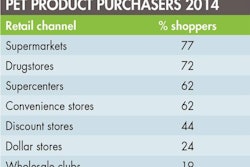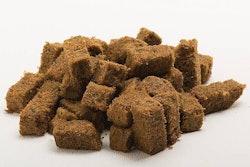American pet owners want the best for their pets, so much so that the pet food category is experiencing a trend in humanization evolving beyond flavors to ensuring nutritional benefits, ingredient quality and manufacturing standards are as high as human food.
Highlighting the impact this growth has had on American pet owners, new research from Mintel reveals that one-quarter of pet owners worry that the pet food they buy is making their pet obese.
Furthermore, 55% of all pet owners agree they worry about filler ingredients in pet food, including grains and meat byproducts. As pets are increasingly considered members of the family for many Americans, standards for pet food, including treats -- the fastest-growing segment in the pet food category -- are on the rise.
70% of households own a pet
Pet ownership is widespread in the US, with 70% of all households owning any type and any number of pets. The number of US households that dote after a single pet is 26%, dropping down to 19% of households owning two pets and 25% owning three or more. Among those who own pets, dogs are the most popular, with 73% of American pet owners owning a dog. As expected, cats are the second most popular pet, with 51% of all American pet owners owning a cat. America’s third most popular pet is fish with 17% ownership among total pet ownership. Pet ownership of small mammals, reptiles, amphibians, birds and other types of pets, lags behind with less than 10% ownership.
Owners of other pets, excluding dogs and cats, are more likely to own three or more pets, reflecting the ease of ownership for these smaller, often caged pets. Households with children have considerably higher rates of pet ownership than those that do not. In fact, 84% of households with children under the age of 18 own pets compared with 63% of those with no children under age 18 in the home.
Diet and nutrition are top concerns for pet owners
Forty-five percent of American pet owners consider whether their pet would like the taste of the pet food they buy as the most important factor in their purchase decision. Second is overall price, which 42% of pet owners identify as an important factor. Products made in the US and natural product offerings are also top purchase considerations for consumers (36% and 32% respectively). While pet owners’ interest in taste reflects perceptions of pets as family members, a growing trend Mintel has identified in American pet owners, overall price will limit the capacity for consumers to upgrade to premium-priced products.
Regarding pet nutrition, American pet owners are as concerned with what is not in their pet’s food as what is. More than half (55%) of pet owners are concerned about the amount of filler ingredients in pet food, such as grains and meat by-products. Nearly as many (49%) feel that the best diet for their pet is a “wild” diet - allowing their pet to eat only what they would have eaten in the wild, such as all-meat diets without artificial ingredients. Interest in pet foods that resemble “wild” diets is highest among millennial pet owners, 56% of whom agree that such diets are best for their pets compared with 47% overall.
Pet owners also express interest in organic diets for their pets with 39% agreeing that organic pet food options are better than non-organic options. Millennials are more inclined (37%) to worry than older generations that the pet food they are buying is making their pet obese (compared with 25% overall). Furthermore, millennials are more inclined (34%) to prepare their pet’s food from scratch (compared to 23% overall).
“The perception that pets are members of the family will continue to define the humanization trend in 2015 and drive price increases in the pet food category in the future. Manufacturers should note that the pet food humanization trend translates into pet owners wanting the same quality and safety standards for pet food as for their own food,” said Amy Kraushaar, US category manager, food and drink and foodservice, at Mintel. “As far as nutrition is concerned, some pet owners express interest in foods that cater to pet-specific diets, such as what their pets would have eaten in the wild. This entails reformulating products to be without grains, artificial ingredients or meat by-products. Consumer interest in pet food that meets human criteria for food health, safety and nutrition will drive pricing, particularly in the wake of ongoing concerns related to pet food recalls. Pet foods with specific attributes that mirror human food trends, like gluten-free, organic and locally sourced, may attract less price-conscious pet owners.”
Pet owners are highly satisfied with the brands of pet food they purchase, with 55% of pet owners reporting they are completely satisfied with their current brand. Experimentation with new pet foods is uncommon among US pet owners, with just 28% saying they sometimes experiment with other pet food brands. As few as one-fifth of pet owners (22%) would be interested in buying variety packs -- which allow them the opportunity to test out new products before switching brands entirely -- but this may be driven by desire for new flavors versus wholly new products or brands, and only 20% have changed pet food brands in the past 12 months.
Treats communicate love from owners
Pet treats are closely associated with the affection pet owners feel for their pets, with 45% of pet owners reporting treats are their way of showing their pet they love them. Mintel research shows that treat-giving behavior as a demonstration of affection increases with pet owner age: 49% of owners age 55-64 see pet treats as a way to show love, compared with just 41% of owners age 18-24. Nearly half of dog owners (48%) give treats daily, compared with 28% of cat owners. Habitual dog treat usage may relate to the role treats play in dog training.
Interestingly, few pet owners rely on the same brand for both pet food and pet treats, as just 16% of American pet owners use the same brand of treats as food. Mintel research suggests that pet owners likely buy different brands of treats and food because they hold treats and food to different standards. While food has to provide nutrition as well as taste, pet treats only have to be enjoyed by pets. Accordingly, 22% of pet owners look for unique flavors and ingredients in their pet treats to appeal to their pets.
“Treats are the fastest growing segment in the pet food category. Because treats are used primarily to demonstrate pet owners’ emotional involvement with their pet, pet owners assess treats more for the flavors and indulgence they offer versus nutrition – which they rely on pet food to provide. Pet treats that leverage this alternate need have more potential to grow,” said Kraushaar.
Humanization leads to market growth
Total US sales of the pet food category were $21 billion in 2014, an increase of 0.4%. Mintel forecasts the pet food market will grow to $22.8 billion in 2019, an increase of 9% from 2014.
“Sales growth in the pet food category in 2014 was limited by lagging rates of American pet ownership. Demographic factors similarly showed slowed growth; households with children, which are most likely to own pets, continued to decline as millennials delay marriage and childbirth. Flat wages undercut expectations that premiumization would drive growth. While pet owners continue to see pets as members of their family, the humanization trend in pet food will more likely involve pet owners looking to healthier pet foods without filler ingredients rather than trading up to premium-priced products,” said Kraushaar.


















